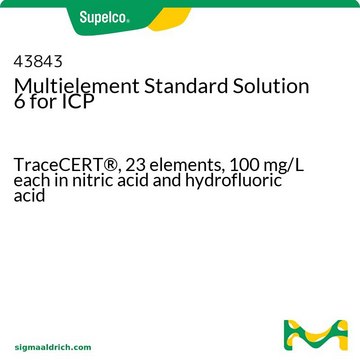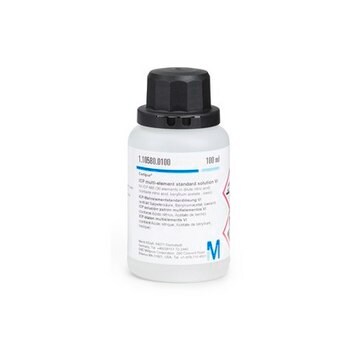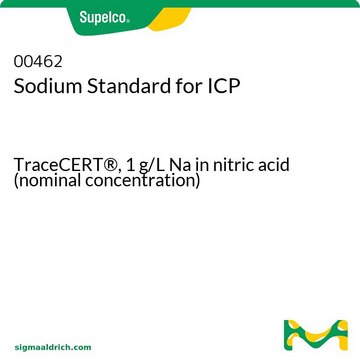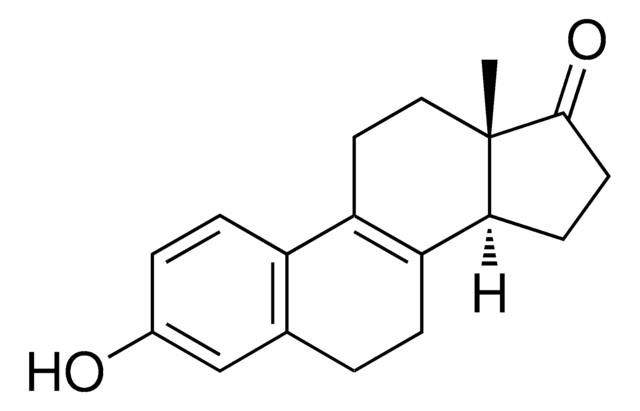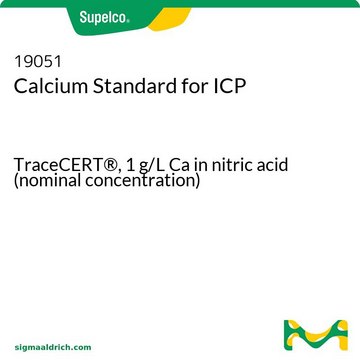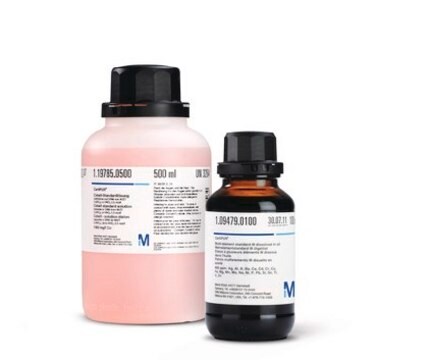1.11355
ICP multi-element standard solution IV
(23 elements in diluted nitric acid) 1000 mg/l: Ag, Al, B, Ba, Bi, Ca, Cd, Co, Cr, Cu, Fe, Ga, In, K, Li, Mg, Mn, Na, Ni, Pb, Sr, Tl, Zn Certipur®
Synonym(s):
Nota 1 A
About This Item
Recommended Products
grade
reference material
Quality Level
product line
Certipur®
technique(s)
ICP: suitable
pH
1 (20 °C in H2O)
density
1.09 g/cm3 at 20 °C
application(s)
industrial qc
pharmaceutical
format
multi-component solution
storage temp.
15-25°C
Related Categories
Application
Analysis Note
Other Notes
Detailed information on our complete workflow solutions for ICP-AAS can be found in our Brochure: High-Purity Chemicals for Inorganic Trace Analysis.
In our effort to be more sustainable, we′re going digital with COAs-download them directly from our website.
Legal Information
Signal Word
Danger
Hazard Statements
Precautionary Statements
Hazard Classifications
Aquatic Acute 1 - Aquatic Chronic 2 - Carc. 1A - Carc. 1B Inhalation - Eye Dam. 1 - Met. Corr. 1 - Muta. 1B - Repr. 1B - Skin Corr. 1B - Skin Sens. 1 - STOT RE 2
Supplementary Hazards
WGK
WGK 3
Regulatory Listings
Regulatory Listings are mainly provided for chemical products. Only limited information can be provided here for non-chemical products. No entry means none of the components are listed. It is the user’s obligation to ensure the safe and legal use of the product.
EU REACH SVHC Candidate List
EU REACH Annex XVII (Restriction List)
Certificates of Analysis (COA)
Search for Certificates of Analysis (COA) by entering the products Lot/Batch Number. Lot and Batch Numbers can be found on a product’s label following the words ‘Lot’ or ‘Batch’.
Already Own This Product?
Find documentation for the products that you have recently purchased in the Document Library.
Customers Also Viewed
Protocols
F&B, elemental analysis, inductively coupled plasma, regulatory, food safety, food chemistry, nutritional value.
Related Content
Atomic spectroscopy techniques like AAS, AES, ICP-OES, and ICP-MS identify and quantify elemental composition in samples.
Atomic spectroscopy uses the energy absorbed or emitted by electrons to identify and quantify the elemental composition of a sample. It includes various analytical techniques, such as AAS, AES, FAA, GFAA, ICP-OES, ICP-MS and XRF.
Atomic spectroscopy uses the energy absorbed or emitted by electrons to identify and quantify the elemental composition of a sample. It includes various analytical techniques, such as AAS, AES, FAA, GFAA, ICP-OES, ICP-MS and XRF.
Atomic spectroscopy uses the energy absorbed or emitted by electrons to identify and quantify the elemental composition of a sample. It includes various analytical techniques, such as AAS, AES, FAA, GFAA, ICP-OES, ICP-MS and XRF.
Our team of scientists has experience in all areas of research including Life Science, Material Science, Chemical Synthesis, Chromatography, Analytical and many others.
Contact Technical Service